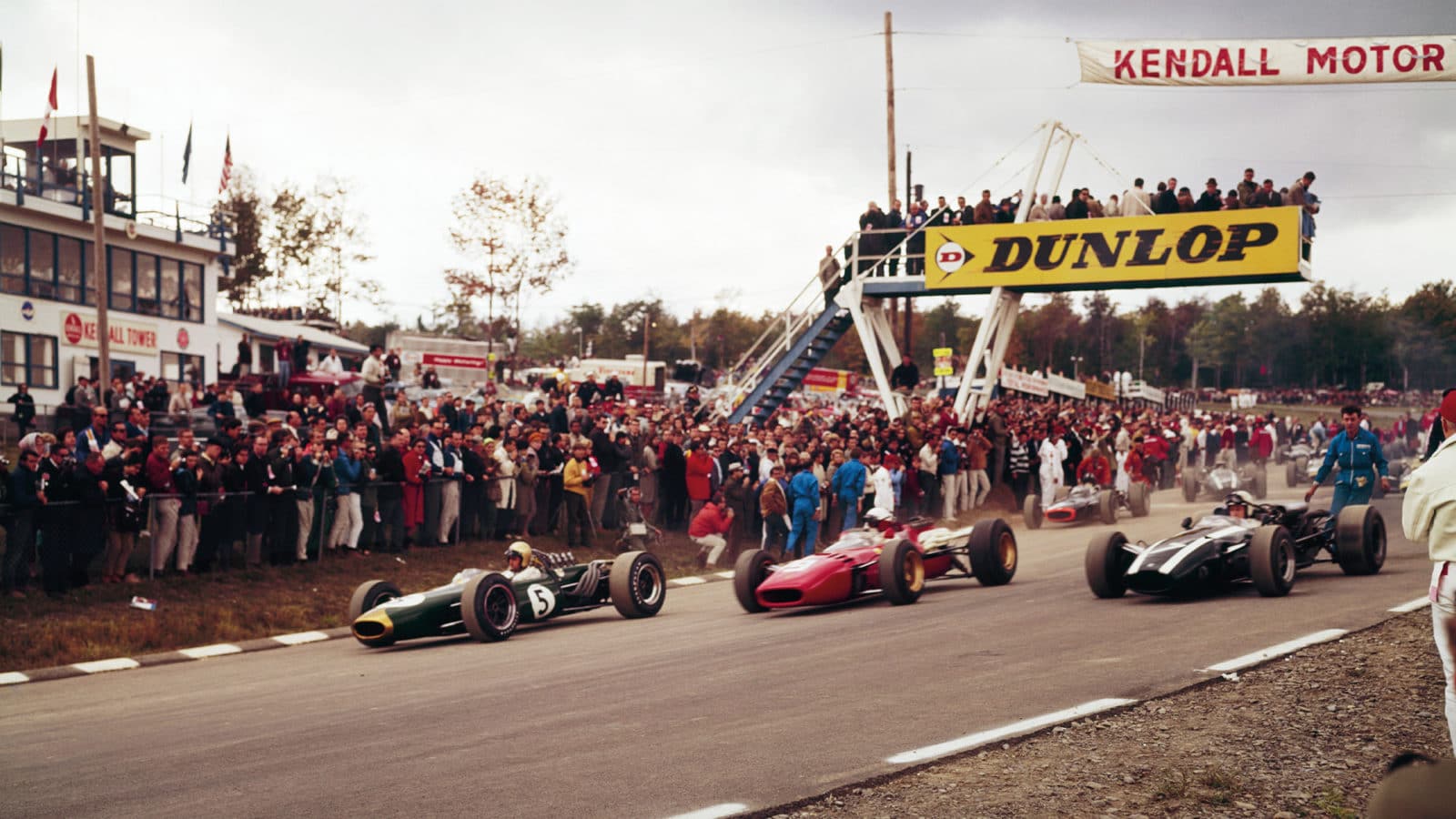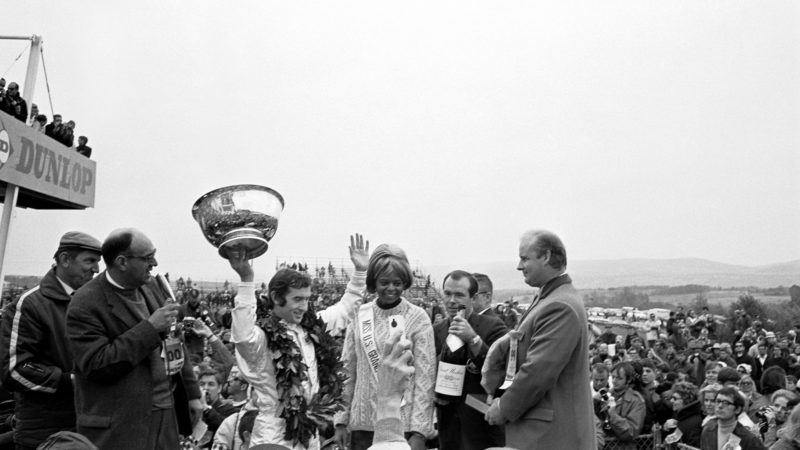The wild F1 weekends at Watkins Glen
From 1961-80 the US Grand Prix was held at Watkins Glen – a wild weekend at times but one appreciated by F1 teams for its end-of-term excitement. Maurice Hamilton, a visitor in the 1970s, tells its story

The grid at 1966’s US GP at Watkins Glen includes Jack Brabham (No5), Lorenzo Bandini (9) and John Surtees (7)
Homely, unruly – and just about everything in between. Watkins Glen was a curious but captivating mix, best summed up by the charm of the provincial town from which the race track got its name – and the torching of a Greyhound bus within the circuit’s bucolic boundary.
Contradiction had always been present from the moment a motley collection of cars came under starter’s orders in the town’s main street to mark the first Watkins Glen Grand Prix in October 1948. A Stutz Blackhawk had lined up alongside an Alfa Romeo 8C touring car and ahead of an 11-year-old Maserati single-seater. Further back, drivers of a Lagonda Rapide and a Jaguar SS counted themselves lucky to be in the race, the 1930s Duesenberg Indy Racer of Mr JJ Brundage having failed to qualify for the 15-car grid, such was the hunger to be a part of the first post-World War II road race in the US.
It was inevitable that the tricky 6.6-mile course should extract its dues as cars frequently left the road. The death of a child in 1952 ruled out further racing – but not before the local Chamber of Commerce had seen the benefit of attracting visitors to the area.
The Watkins Glen Grand Prix Committee was formed, headed by local man Cameron Argetsinger (who had taken part in the 1948 race) and charged with finding a permanent venue. The creation of a track on high ground five miles west of the town coincided with F1 looking for a new home in North America.
“The Seneca Lodge was ‘party central’. Genesee beer was the staple diet”
The United States Grand Prix had been staged at Sebring and Riverside in 1959 and ’60. With neither venue being deemed completely satisfactory, Watkins Glen ensured F1’s attention in 1961 by announcing a substantial prize fund and a circuit that looked half-decent. Further approval was guaranteed by a friendly welcome and the stunning scenery of the Finger Lake region in autumn. Watkins Glen went on to provide a home for the US GP for two decades.
Frequently coming at or close to season’s end, ‘The Glen’ was considered a great place to be with the layout of having all the teams under one roof and allowing fans to get close to the teams. The layout also presented an informal marketplace at the end of the season as mechanics raised beer money through the sale of soon-to-be-redundant uniforms and race car parts.
The barn-like structure also came close to wiping out the entire F1 circus in 1968. On the eve of first practice, Ken Tyrrell had been helping out by using a five-gallon churn to add fuel to one of his cars when the area suddenly became engulfed in flames. Only the action of Mike Barney in the neighbouring stall saved the day as the McLaren mechanic grabbed a dry powder extinguisher – a contraption on iron wheels – and smothered the fire.

Jackie Stewart led every lap of the 1968 US GP in the Matra for his first American victory
Tyrrell, having quickly dropped the near-empty churn, was very lucky to escape injury. Typically he brushed aside the incident and focused on ensuring a win for Jackie Stewart.
Such was the financial significance of this race that Tyrrell entered a third car for Peter Revson in 1971. On race day, the American was a DNF, but a maiden victory for François Cevert ensured Ken went home with a cool $50,000.
Two years later, money would have no meaning whatsoever when Cevert was killed during practice. The charismatic Frenchman, in line to replace the about-to-retire Stewart as team leader, lost control at the Esses, a fast flick at the top of a hill. The Tyrrell hit the Armco on the right, ricocheted across, slamming into the opposite barrier with such violence that the car was upended and virtually torn in two. It had been horrifying, and yet little was said officially about the barrier ripping apart.
The question could not be avoided a year later. Helmuth Koinigg, in only his second grand prix, was decapitated when the Austrian’s Surtees went straight on at the end of the back straight, demolished catchfences and sliced through the barrier.
“The buzz that year was the continuing confrontation between Hunt and Lauda”
Travelling to this race as a fan with Page & Moy tours, I had returned by coach to our hotel 40 miles away, the main topic of conversation being a 1-2 for Brabham, James Hunt finishing a fine third for Hesketh and Emerson Fittipaldi securing his second world title. It was only days later that I learned about Koinigg.
My second visit to The Glen in 1976 was under happier circumstances. The unruliness of the place that two years previously had seen a Greyhound bus stolen from the coach park and set alight in an anarchic public enclosure called The Bog (on account of its marshy ground), had been tamed. And as a young and not yet professional journalist my focus in 1976 was scoring media accreditation of some sort.
Andrew Marriott (formerly of this parish) introduced me and my tatty collection of club race reports from Lydden Hill to Bob Kelly, a bearded and kindly press officer far removed from the brusque self-importance of some of his European counterparts. As far as I was concerned, receiving the official lanyard in that bustling press room was like being awarded a gong in Buckingham Palace.
I was able to drink in the atmosphere in the pitlane. The buzz that year was the continuing confrontation between Hunt and Lauda, each having his own battle as James dealt with the recent setback of disqualification from victory at Brands Hatch and Niki continued to make his extraordinary comeback from near-death at the Nürburgring. Hunt would do his cause the power of good with a repeat of an impressive win in Canada the previous weekend. After such a result, there was only one place to be.
The Seneca Lodge was ‘party central’ for Watkins Glen. The hunting cabin with its timber façade was packed with racing memorabilia and memories of deeds of derring-do at the racetrack a few miles up the road. Draught Genesee beer was the staple diet, bar staff clanging a bell when included in a round. It rang a lot on the night of October 10, 1976, but nothing would match the mayhem when the race winner suddenly arrived, several sheets to the wind and with a girl on each arm. Along the way, someone had plonked a builder’s hat, complete with a flashing light, on James’s head.
It was typical of the home-grown informality that was unique to this corner of New York State (the following year I found myself sharing a hotel with Ronnie Peterson and Ken Tyrrell) but it couldn’t last in the face of the increasingly fussy list of F1 priorities.
By 1980, the technical centre was no longer big enough and the draughty pits did not suit designer clothes any more than a muddy paddock and a flooded access tunnel were ideal for F1 personnel and spectators. With $800,000 owing and never likely to be paid to the teams, a good enough reason was found to bring closure to this unruly chapter of F1 in the US.
